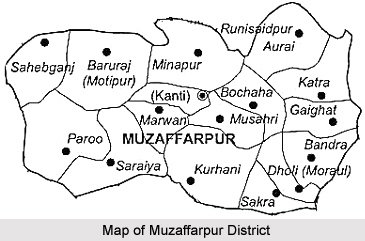Muzaffarpur District is among the 38 districts of Bihar with Muzaffarpur town as its district headquarters. Muzaffarpur District is located between latitude 25 degree 54 minutes to 26 degree 23 minutes north and longitude 84 degree 53 minutes to 85 degree 45 minutes east. The average altitude of the district is 170 meters above the sea level.
 The total geographical area of Muzaffarpur District is 317591 hectares including a total cultivated area of 247721 hectares. Muzaffarpur District is bounded in the north by Sitamarhi District and East Champaran District, in the south by Vaishali and Saran district, in the east by Darbhanga District and Samastipur District and in the west by Saran District and Gopalganj District. Total population of Muzaffarpur District according to 2001 Census is 3743836, out of which male population is 1941480 and female population is 1802356.
The total geographical area of Muzaffarpur District is 317591 hectares including a total cultivated area of 247721 hectares. Muzaffarpur District is bounded in the north by Sitamarhi District and East Champaran District, in the south by Vaishali and Saran district, in the east by Darbhanga District and Samastipur District and in the west by Saran District and Gopalganj District. Total population of Muzaffarpur District according to 2001 Census is 3743836, out of which male population is 1941480 and female population is 1802356.
History of Muzaffarpur District
Muzaffarpur District, more popularly known as `The Land of Leechi` was created in the year 1875 for the sake of administrative convenience by splitting up the earlier district of Tirhut. The present district of Muzaffarpur came was named after Muzaffar Khan, Revenue Officer under British rule.
The recorded history of the district dates back to the rise of Vrijjan Republic. The centre of political power also shifted from Mithila to Vaishali. Vrijjan Republic was a confederation of eight clans of which the Licchavis Tribe was the most powerful and influential. Even the powerful kingdom of Magadha had to conclude matrimonial alliances in 519 BC with the neighbouring estates of the Licchavis. Ajatshatru invaded Vaishali and extended his sway over Tirhut. It was at this time that Patliputra (modern Patna) was founded at the village Patali on the banks of Ganga River and Ajatshatru built an invincible fortress to keep vigil over the Licchavis on the other side of the river.
Pala kings continued to have their hold over Tirhut until 1019 AD. Chedi kings of Central India also exercised their influence over Tirhut till they were replaced by the rulers of the Sena dynasty towards the close of the 11th century. It was in 1323; Ghiyas- ud- din Tughlaq, established his control over the district. The history of Muzaffarpur will remain incomplete without a reference to the Simraon dynasty (in the north-east part of Champaran) and its founder Nanyupa Deva who extended his power over Mithila and Nepal. During the regime of Harasimha Deva, the last king of the dynasty, Tughlaq Shah invaded Tirhut in 1323 and gained control over the territory.
Towards the close of the 14th century the whole of North Bihar including Tirhut passed on to the kings of Jaunpur and remained under their control for nearly a century until Sikandar Lodi of Delhi defeated the king of Jaunpur. The victory of British East India Company in 1764 at the Battle of Buxar gave them control over Bihar and they succeeded in subduing the entire district. Muzaffarpur District continued to play a prominent role in the country"s struggle for freedom.
Demography of Muzaffarpur District
According to the Population Census in the year 2011, Muzaffarpur District had population of 4,778,610. Out of which the male and female were 2,517,500 and 2,261,110 respectively. The population of Muzaffarpur District constituted 4.60 percent of total population of Muzaffarpur District. The average literacy rate of Muzaffarpur in 2011 was 65.68 compared to 47.95 of 2001. If things are looked out at gender wise, male and female literacy were 73.61 and 56.82 respectively. The total literate in Muzaffarpur District were 2,601,665 of which male and female were 1,539,154 and 1,062,511 respectively.
Education of Muzaffarpur District
Muzaffarpur District is considered as one of the biggest educational and commercial hubs of Bihar. Muzaffarpur District is the second leading centre of education in Bihar. It has a medical and an engineering college and is bench of one of the oldest universities of Bihar called Bihar University, now known as Dr B R Ambedkar Bihar University. Dr Rajendra Prasad, the First President of India was a teacher in the Greer Bhumihar Brahman College located in Muzaffarpur.



















